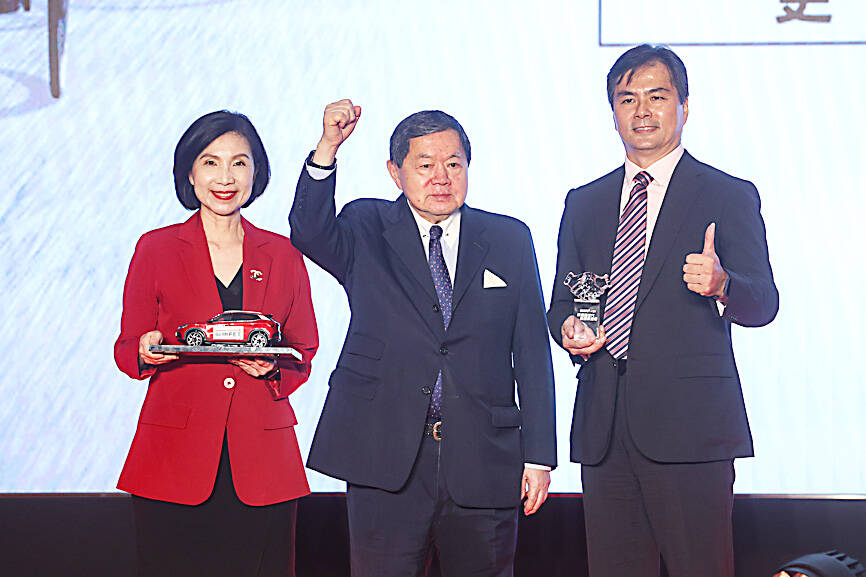Far EasTone Telecommunications Co (遠傳電信) yesterday said it aims to expand its number of mobile subscribers to about 10 million, or about one-third of the market, as part of its strategy in a new competitive landscape following market consolidation.
Far EasTone made the remarks after last month receiving conditional approval from the Fair Trade Commission to acquire Asia Pacific Telecom Co (亞太電信), clearing the final hurdle to proceed with the deal. The transaction is to take effect next quarter.
“The number of telecoms will shrink following the merger of Far EasTone and Asia Pacific, but the market competition will intensify,” Far EasTone chairman Douglas Hsu (徐旭東) told reporters.

Photo: CNA
Far EasTone would be competing head-to-head with its rivals, which have almost identical subscriber bases, following the acquisition of Asia Pacific, company president Chee Ching (井琪) said.
The new entity would have a combined 9.2 million mobile subscribers, lagging behind Chunghwa Telecom Co’s (中華電信) 11.15 million, but ahead of an estimated 9.8 million for Taiwan Mobile Co (台灣大哥大) after it acquires Taiwan Star Telecom Corp (台灣之星).
The nation’s competition watchdog is widely expected to give the go-ahead later this month at the earliest to Taiwan Mobile’s bid to absorb Taiwan Star after wrapping up a 30-day review.
As a result, the number of telecoms in Taiwan would shrink to three from five.
Far EasTone said that more than 36 percent, or about 2 million, of its post-paid subscribers, not including Asia Pacific’s, are 5G users.
To woo more mobile subscribers from rivals, Far EasTone yesterday rolled out new service plans with affordable monthly rates from NT$149 to NT$399 (US$4.66 to US$12.48) and heavy subsidies for smartphones and home appliances.
The new service plans target 4G users and their potential to upgrade to 5G service.
One of its promotions for new 5G service subscribers is a free Samsung smartphone and a rice cooker for a minimum 12-month subscription plan at NT$599 per month plus a NT$1 fee.
Far EasTone expects to complete the network integration with Asia Pacific within one month after it takes effect.
The company would operate 12,500 base stations nationwide as a result of infrastructure optimization, it estimated.
The telecom said it does not expect the merger to incur significant increases in capital spending due to base station additions.
It has budgeted NT$9 billion for this year’s capital expenditure, down from an outlay of NT$9.9 billion last year.
Far EasTone expects the merger to significantly increase its spectrum resource, especially in the low-band bandwidth, or lower-than 1-gigahertz band, which is considered the most efficient band.
Far EasTone would operate 50 megahertz of bandwidth, up 66 percent.
The company’s 5G bandwidth would also rise 50 percent to 120 megahertz.

UNCERTAINTY: Innolux activated a stringent supply chain management mechanism, as it did during the COVID-19 pandemic, to ensure optimal inventory levels for customers Flat-panel display makers AUO Corp (友達) and Innolux Corp (群創) yesterday said that about 12 to 20 percent of their display business is at risk of potential US tariffs and that they would relocate production or shipment destinations to mitigate the levies’ effects. US tariffs would have a direct impact of US$200 million on AUO’s revenue, company chairman Paul Peng (彭雙浪) told reporters on the sidelines of the Touch Taiwan trade show in Taipei yesterday. That would make up about 12 percent of the company’s overall revenue. To cope with the tariff uncertainty, AUO plans to allocate its production to manufacturing facilities in

Taiwan will prioritize the development of silicon photonics by taking advantage of its strength in the semiconductor industry to build another shield to protect the local economy, National Development Council (NDC) Minister Paul Liu (劉鏡清) said yesterday. Speaking at a meeting of the legislature’s Economics Committee, Liu said Taiwan already has the artificial intelligence (AI) industry as a shield, after the semiconductor industry, to safeguard the country, and is looking at new unique fields to build more economic shields. While Taiwan will further strengthen its existing shields, over the longer term, the country is determined to focus on such potential segments as

TAKING STOCK: A Taiwanese cookware firm in Vietnam urged customers to assess inventory or place orders early so shipments can reach the US while tariffs are paused Taiwanese businesses in Vietnam are exploring alternatives after the White House imposed a 46 percent import duty on Vietnamese goods, following US President Donald Trump’s announcement of “reciprocal” tariffs on the US’ trading partners. Lo Shih-liang (羅世良), chairman of Brico Industry Co (裕茂工業), a Taiwanese company that manufactures cast iron cookware and stove components in Vietnam, said that more than 40 percent of his business was tied to the US market, describing the constant US policy shifts as an emotional roller coaster. “I work during the day and stay up all night watching the news. I’ve been following US news until 3am

COLLABORATION: Given Taiwan’s key position in global supply chains, the US firm is discussing strategies with local partners and clients to deal with global uncertainties Advanced Micro Devices Inc (AMD) yesterday said it is meeting with local ecosystem partners, including Taiwan Semiconductor Manufacturing Co (TSMC, 台積電), to discuss strategies, including long-term manufacturing, to navigate uncertainties such as US tariffs, as Taiwan occupies an important position in global supply chains. AMD chief executive officer Lisa Su (蘇姿丰) told reporters that Taiwan is an important part of the chip designer’s ecosystem and she is discussing with partners and customers in Taiwan to forge strong collaborations on different areas during this critical period. AMD has just become the first artificial-intelligence (AI) server chip customer of TSMC to utilize its advanced